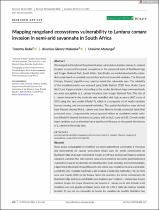| dc.contributor.author | Dube, Timothy | |
| dc.contributor.author | Maluleke, Xivutiso Glenn | |
| dc.contributor.author | Mutanga, Onisimo | |
| dc.date.accessioned | 2023-06-15T13:26:43Z | |
| dc.date.available | 2023-06-15T13:26:43Z | |
| dc.date.issued | 2022 | |
| dc.identifier.citation | Dube, T., Maluleke, X.G. and Mutanga, O., 2022. Mapping rangeland ecosystems vulnerability to Lantana camara invasion in semi‐arid savannahs in South Africa. African Journal of Ecology, 60(3), pp.658-667. | en_US |
| dc.identifier.uri | https://doi.org/10.1111/aje.12951 | |
| dc.identifier.uri | http://hdl.handle.net/10566/9103 | |
| dc.description.abstract | We mapped and modelled the potential areas vulnerable to Lantana camara (L. camara) invasion in semi-arid savannah ecosystems in the communal lands of Bushbuckridge and Kruger National Park, South Africa. Specifically, we modelled potentially vulner-able areas based on remotely sensed data and environmental variables. The Maximal Entropy (Maxent) algorithm was used to model the vulnerable area. The reliability of the modelled results was assessed using Skills Statistic (TSS), Area Under Curve (AUC) and Kappa statistics. According to the results, Bushbuckridge communal lands are more susceptible to L. camara invasions than Kruger National Park. | en_US |
| dc.language.iso | en | en_US |
| dc.publisher | Journal of Ecology | en_US |
| dc.subject | Environmental variables | en_US |
| dc.subject | Invasive plants encroachment | en_US |
| dc.subject | L. camara | en_US |
| dc.subject | Maxent | en_US |
| dc.subject | Rangeland ecosystems | en_US |
| dc.title | Mapping rangeland ecosystems vulnerability to Lantana camarainvasion in semi-arid savannahs in South Africa | en_US |
| dc.type | Article | en_US |

